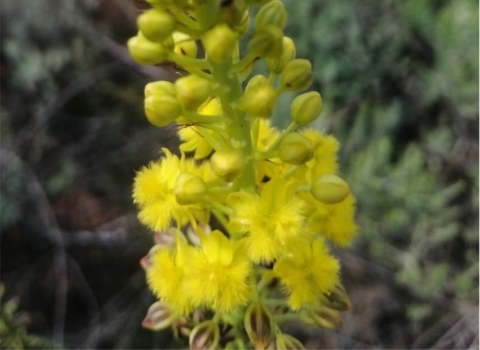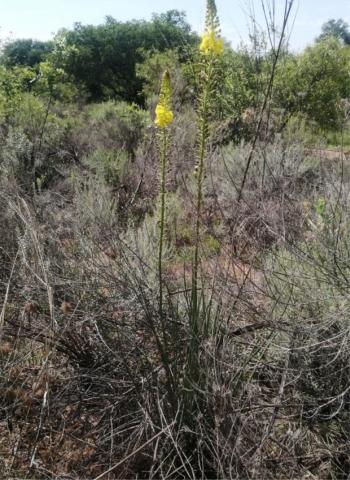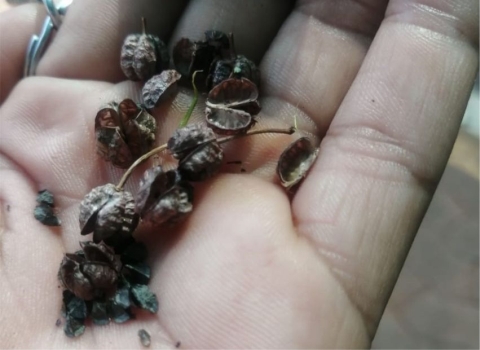Bulbine angustifolia
Bulbine angustifolia Poelln.
Family: Asphodelaceae
Common names: narrow-leaved bulbine, slender bulbine, golden lily (Eng.); rooistamper, kopieva, katstert, koorsbossie (Afr.)
Introduction
Bulbine angustifolia is a stunning plant with delicate, bright yellow flowers and slender leaves, that can add a touch of beauty to any garden or landscape. However, beauty is not its only attribute, this hardy plant is also known for its medicinal properties and has been used for centuries by indigenous people to treat various ailments. It is a low-maintenance plant that is easy to cultivate, which has led to it becoming increasingly popular among gardeners, landscapers, and herbalists.

Description
Description
Bulbine angustifolia is an herbaceous tufted perennial with a woody rhizome, that produces tall, slender, branching flower stalks that can reach up to 700 mm in height. They are succulent and have a reddish-brown color. The leaves are fleshy, long and narrow, and are about 200-400 mm in length and 2-5 mm in width. They taper towards the tip and have a bluish-green colour. The inflorescence is a long, dense spike that bears multiple, bright yellow flowers arranged in a raceme and grows up to 360 mm long. The individual flowers are small, about 10-15 mm in diameter, and have 6 petals that are fused at the base. The flowers have a star-shaped appearance and are borne on long, slender pedicels. The plant produces a narrow, cylindrical capsule that is about 10 mm long. The capsule splits open when ripe to release small black winged seeds. The seeds of Bulbine angustifolia are small, shiny, and black.
The flowering period for Bulbine angustifolia occurs in late spring or early summer, although it may continue to bloom sporadically throughout the growing season in optimal conditions.

Conservation Status
Status
Bulbine angustifolia is currently listed as Least Concern (LC) in the Red List of South African Plants, because the species has a wide distribution, and it is not facing any major threats.
Distribution and habitat
Distribution description
Bulbine angustifolia is endemic to southern Africa, occurring in South Africa, Namibia, Botswana and Eswatini. In South Africa it occurs in Gauteng, Limpopo, Northern Cape and Free State provinces. It can be found growing in rocky outcrops, sandstones slopes, and grasslands.
The plant is adapted to survive harsh, dry conditions and it is commonly found in arid and semi-arid regions. It is tolerant of both heat and cold and can survive temperatures ranging from 0°C to 45°C.

Derivation of name and historical aspects
History
The genus name Bulbine is derived from the Latin word bulbus, meaning ‘bulb’, referring to the bulbous nature of the plant’s roots. The species name angustifolia is derived from the Latin words angustus meaning ‘narrow’, and folium meaning ‘leaf’ which refers to the plant’s narrow leaves.
Bulbine angustifolia was first described by German botanist, Karl von Poellnitz, in 1943. Bulbine angustifolia belongs to the Asphodelaceae family, a large family of flowering plants that includes more than 40 genera, and around 800 species. Most species in this family are herbaceous perennials, and they are found primarily in Africa and Madagascar. The genus Bulbine is relatively large and diverse, containing approximately 82 species of perennial herbs or shrubs. Most species are native to South Africa and Namibia, but there are also a few species found in other parts of Africa, as well as in Yemen and Saudi Arabia.

Ecology
Ecology
Bulbine angustifolia is an important component of vegetation in many of the arid and semi-arid regions where it occurs. The plant is adapted to survive in dry and infertile soils and can tolerate both high temperatures and periods of drought. It is a succulent plant, which means that it stores water in its leaves and stems, allowing it to survive long periods without rainfall. The plant’s leaves are also covered in a waxy coating that helps to reduce water loss through transpiration.
The flowers of Bulbine angustifolia are pollinated by a range of insects, including bees, butterflies, and beetles. The plant produces large quantities of nectar, which attracts these pollinators. The fruit of the plant is a capsule that splits open to release the seeds. Bulbine angustifolia is also an important food source for a range of animals, including tortoises, lizards, and birds. The plant’s succulent leaves provide a source of moisture, while the seeds are an important source of food for seed-eating birds. Overall, Bulbine angustifolia plays an important ecological role in the ecosystems where it occurs, providing habitat and food for many organisms, and helping to stabilize the soil.
Uses
Use
Bulbine angustifolia has been used in traditional medicine in South Africa for centuries. The plant was used by the Khoe and San people to treat a range of ailments, including burns, wounds and insect bites. The sap of the plant was also used as a remedy for sore eyes and mouth sores. Studies have shown that the plant contains a range of bioactive compounds, including flavonoids and alkaloids, that may have inflammatory and antioxidant effects.
In traditional medicine, Bulbine angustifolia has been used to treat a range of ailments, including skin conditions, burns, and inflammation. It has also been studied for its potential as a natural remedy for diabetes as an anti-inflammatory agent. Additionally, the plant is commonly used in landscaping and gardening, as it is easy to grow and has attractive foliage and flowers.

Growing Bulbine angustifolia
Grow
Bulbine angustifolia is an easy plant to grow and can be propagated from seed or division.
Seeds should be sown in a well-drained soil mix in early spring and kept moist until they germinate. The plant requires full sun to partial shade to thrive. It is drought-tolerant and does not require frequent watering, water only when the soil has dried out completely. Pruning should be done to remove any dead or damaged foliage.
Propagate Bulbine angustifolia through vegetative propagation: when the plant has developed into a large clump, it can be lifted up and divided into smaller clumps. Transplant into well-drained, sandy soil, place it in full sun and water once a week or when it is necessary. Vegetative propagation is best done in spring, before it flowers
References
- Dold, A.P. & Cocks, M.L. 2002. The trade in medicinal plants in the Eastern Cape Province, South Africa. South African Journal of Science 98: 589–597.
- Mucina, L. & Rutherford, M.C. (eds) 2006. The vegetation of South Africa, Lesotho and Swaziland. Strelitzia 19. South African National Biodiversity Institute, Pretoria.
- Plants of the World Online, Bulbine angustifolia Poelln. https://powo.science.kew.org/taxon/urn:lsid:ipni.org:names:532125-1. Accessed 18/05/23.
- Pope, G.V. 2001. Flora Zambesiaca. Royal Botanic Gardens, Kew, London.
- Raimondo, D., Von Staden, L., Foden, W., Victor, J.E., Helme, N.A., Turner, R.C., Kamundi, D.A. & Manyama, P.A. (eds) 2009. Red list of South African plants. Strelitzia 25. South African National Biodiversity Institute, Pretoria.
- Van Wyk, B. E., Van der Berg, E. & Desmet, P.G. 2006. Bulbine L. National Botanical Institute, Pretoria.
- Von Poellnitz, K. 1939. Notes on South African Aloineae. Journal of South African Botany 5 (1): 29-35.
Credits
Rofhiwa Ingrid Mudau and Mmapaseka Blessing Ledwaba
Pretoria National Botanical Garden
May 2023
Acknowledgements: the authors thank Lesego Maunatlala for assistance with the research.
Plant Attributes:
Plant Type: Succulent
SA Distribution: Free State, Gauteng, Limpopo, Northern Cape
Soil type: Sandy, Loam
Flowering season: Spring, Early Summer
PH: Acid, Neutral
Flower colour: Yellow
Aspect: Full Sun
Gardening skill: Easy
Special Features:
Horticultural zones








Rate this article
Article well written and informative
Rate this plant
Is this an interesting plant?
Login to add your Comment
Back to topNot registered yet? Click here to register.